With the 2017-18 NHL season over, it’s time for the Detroit Red Wings to evaluate their performance and make roster decisions heading into the 2018 NHL Draft and free agency. As the rebuild progresses, this time becomes more and more important in producing Detroit’s next winner.
During his press conference on locker clean out day, Ken Holland shared his vision for Detroit’s rebuild with the media and fans. His goal—backed by ownership—is to get younger this summer and expedite the roster revamp.
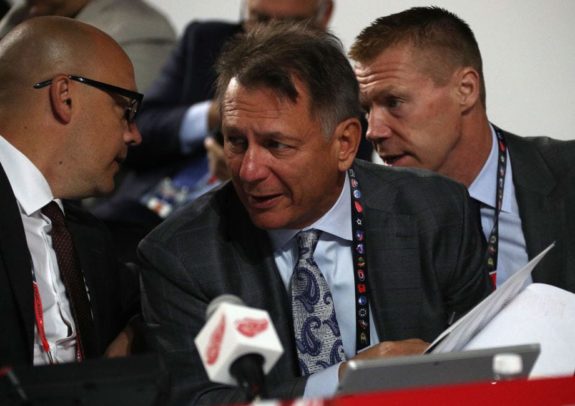
To bring in more youth, some players on the roster may not be back this fall whether they exit by free agency, trade, or another manner. This evaluation time period will directly determine their fate, as management reviews its players’ performance, salary commitments, and career outlook.
While Holland, Blashill, and company are evaluating their roster and walking through upcoming offseason events, we’ll be doing the same as part of the 2018 Red Wings Summer Rebuild Series. Starting with grading Detroit’s forwards, we’ll discuss prospects, the draft, free agency, and more:
- Red Wings Final Grades, Pt. 2: Defense & Goalies
- Red Wings 2018 Prospects Update
- Red Wings 2018 NHL Draft Preview
- 2018 Red Wings Free Agency Outlook
- Summer 2018 Red Wings Prospect Rankings
- 2018-19 Red Wings Season Preview & Rebuild Guide
Red Wings Grades: Methodology
Like last year, each forward was graded on their output, role execution, and, since we’re in the middle of the rebuild, how they grew compared to last year and throughout the season.
In addition to traditional player stats, I’ve developed some high-level metrics to evaluate the impact a player had on scoring, whether that be for or against. Offensive Efficiency Rating (OER) and Defensive Efficiency Rating (DEF) are calculated by taking on-ice goals against and goals for and comparing them to expected goals against or goals for during five-on-five play, with other “fault” variables factored in. A score of 1.00 means that a player allowed/scored what was expected of their role and on-ice events. A higher score indicates that the player performed better than anticipated, while a lower score means that the player’s presence on the ice resulted in more goals against or fewer goals for than expected of his play and role.
Red Wings Forwards’ Grades
Below are the grades, stats, and evaluation notes for Detroit’s forwards and hybrid/rover/all-around-good-guy Luke Witkowski.
Justin Abdelkader: C
Stats: 75 GP – 13 G – 22 A – 35 PTS – 78 PIM
OER: 0.97
DER: 0.87
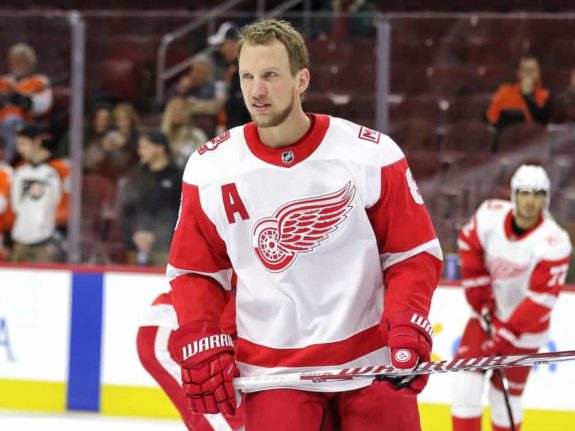
Detroit needs more from its newest alternate captain. Justin Abdelkader performed adequately in a purely shutdown role but is falling behind on the depth chart for top-six minutes. His contract has come into question but he continues to be a leader for the Red Wings’ young players, and the franchise values that contribution. But as those players grow, Abdelkader’s role will diminish at the same rate.
Related: Abdelkader’s Offseason Trade Value
Andreas Athanasiou: C
Stats: 71 GP – 16 A – 17 A – 33 PTS – 16 PIM
OER: 0.98
DER: 0.86
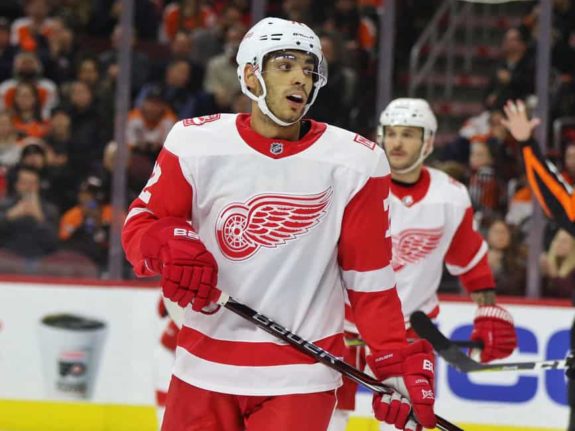
Consistently inconsistent, Andreas Athanasiou may find himself with another team next year. His defense still isn’t up to par, but he’s a dynamic player on offense. Will the Red Wings go through another contract negotiation process knowing his potential or deal Athanasiou for help on defense?
Tyler Bertuzzi: B+
Stats: 48 GP – 7 G – 17 A – 24 PTS – 39 PIM
OER: 1.18
DER: 0.84
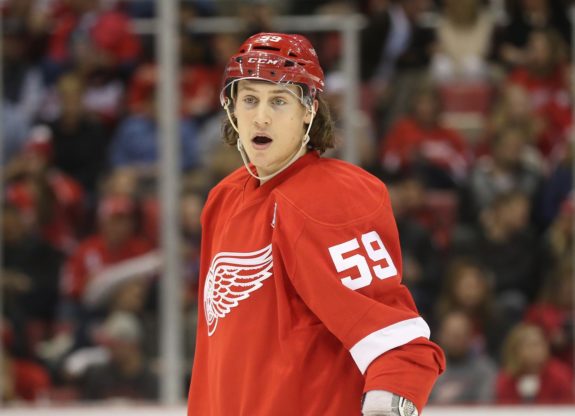
After Tomas Tatar was dealt, Tyler Bertuzzi was given a chance to play alongside Henrik Zetterberg and looked right at home flanking the captain. But so do most Red Wings players. Also, while playing on Zetterberg’s line, Bertuzzi was on the ice for a few too many goals against.
Those two items were really the only knocks against him. After looking out of place last season, Bertuzzi competed like a true NHL pro this year. His offensive contributions surpassed expectations and provided the fans and organization with a rare bright spot down the stretch. Expect him to take on a larger role next season – one where he’ll need to create his own offense rather than rely on Zetterberg’s wizardry.
David Booth: C+
Stats: 28 GP – 4 G – 1 A – 5 PTS – 10 PIM
OER: 0.72
DER: 0.90
Heading into the season, there really wasn’t much expected of David Booth. In the end, he provided a good storyline and competed hard every practice. It would have been nice to give Booth’s roster spot to a prospect but for a player who didn’t see the ice very much, the veteran and the Red Wings matched up well.
Martin Frk: C
Stats: 68 GP – 11 G – 14 A – 25 PTS – 14 PIM
OER: 0.95
DER: 0.77
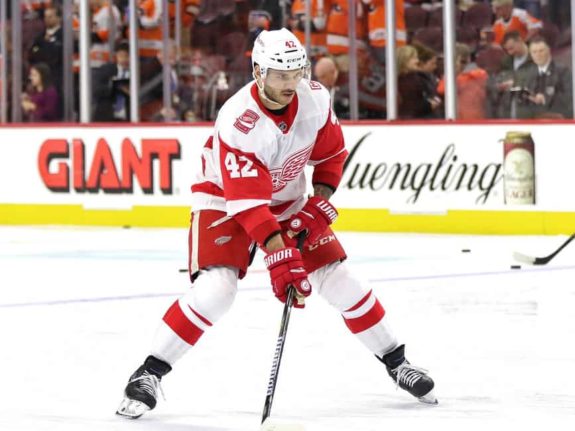
For Martin Frk, his and Athanasiou’s seasons had the same plot lines: Good offensive output but did not factor much defensively. The difference for Frk, though, was that he mostly played fourth line minutes.
Flanking defensive-minded centers like Dominic Turgeon or Luke Glendening isn’t ideal for an offensive threat like Frk but he still managed to be on the ice for a few too many goals against. He will need to address this aspect of his game over the offseason or he may lose ice time to the likes of Evgeny Svechnikov, Michael Rasmussen, and others in the fall.
Luke Glendening: B-
Stats: 69 GP – 11 G – 8 A – 19 PTS – 17 PIM
OER: 0.71
DEF: 0.87
After a brutal 2016-17 season, Luke Glendening rebounded for 11 goals in 69 games this year. If he was able to stay healthy, “LGD” would have bested his career-high 12 goals which he scored across all 82 games during the 2014-15 campaign.
Defensively, Glendening and Dylan Larkin were effective penalty-killers and the former undrafted free agent also won an impressive 58 percent of his faceoffs. No other Red Wings center topped 50 percent in the circle this season. But five-on-five, he will need to prevent more goals from being scored next season, especially if he continues to be Detroit’s go-to defensive zone center.
Related – The Grind Line: 5 Reasons for Red Wings Optimism
Darren Helm: B-
Stats: 75 GP – 13 G – 18 A – 31 PTS – 39 PIM
OER: 0.91
DEF: 1.09
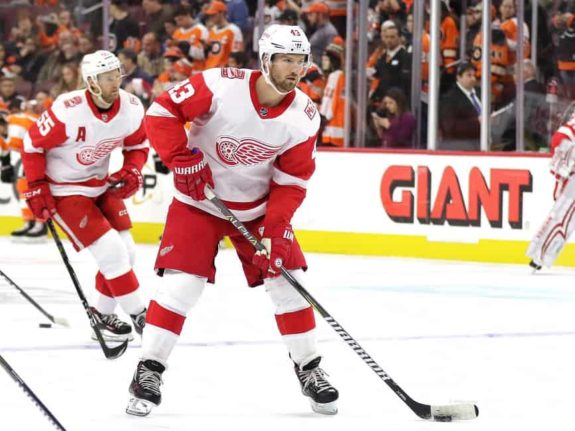
Quietly, Darren Helm had a breakthrough campaign for the Red Wings. He was on the verge of another abysmal season but an impressive month of February—where he led the Red Wings with ten points in 14 games—set the tone for the rest of the year.
Helm’s offensive numbers warranted a spot on Larkin and Anthony Mantha’s line to end the year after spending most of the season in a shutdown role alongside Frans Nielsen. On that defense-focused third line, Helm and his linemates were tasked with keeping opponents’ top players at bay. There his offensive stats faltered but he did execute his role to a reasonable degree.
Related: Darren Helm’s Offseason Trade Value
Dylan Larkin: A-
Stats: 82 GP – 16 G – 47 A – 63 PTS – 61 PIM
OER: 1.15
DER: 0.79
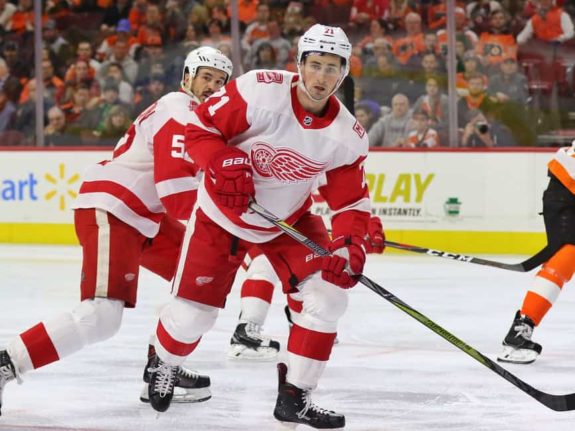
It was a breakout season for Detroit’s franchise center. Larkin took another big step forward in his development, becoming Detroit’s No. 1 pivot and leading the team in scoring, with most of those points coming at even-strength.
After his new contract is signed this offseason, Larkin will need to continue growing next year in order to help the Red Wings return to contention. Cutting down on his penalties and establishing himself as a power play threat are two high priorities.
Anthony Mantha: B+
Stats: 80 GP – 24 G – 24 A – 48 PTS – 52 PIM
OER: 1.14
DER: 1.01
In my opinion, Mantha resembles Johan Franzen in terms of how they compete. Laser shot, big body, scoring touch around the net, streaky – they even have reversed numbers (Franzen’s #93 to Mantha’s #39).
This season, all aspects of Franzen’s game were exemplified by Mantha. His defensive game improved from the previous year, but Blashill still wants Mantha to play with more intensity with the hope that he’s able to step his offensive game up another level. Perhaps Detroit’s former first-round pick can reach Franzen-type numbers next season: 30 goals and about 60 points.
Frans Nielsen: B-
Stats: 79 GP – 16 G – 17 A – 33 PTS – 14 PIM
OER: 0.88
DER: 1.06
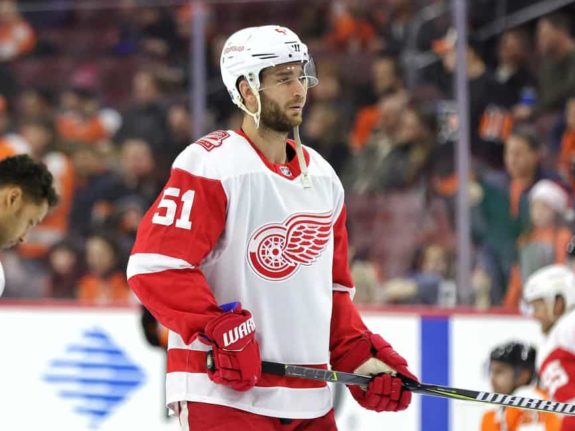
Tasked with lining up against opponents’ top players every night, Nielsen did not disappoint defensively. His 2.15 even-strength goals against per 60 only trailed Gustav Nyquist, Luke Witkowski, and Zetterberg for tops among Red Wings forwards.
However, the Red Wings need more from their second-highest paid forward. Going up against the league’s top players is a tall task but Detroit needs more than 23 even-strength points from Nielsen. Comparatively, Bertuzzi registered one less even-strength point in 31 fewer games this season. Next year, Nielsen will need to bring more to the table than just his defensive prowess if the Red Wings are going to go anywhere.
Gustav Nyquist: B
Stats: 82 GP – 21 G – 19 A – 40 PTS – 20 PIM
OER: 1.00
DER: 1.09
Overall, Nyquist had a respectable year for the Red Wings. But like Nielsen, Detroit just needs more from him. His 21 goals and 40 points are solid, just not first line numbers. Neither were his eight power-play points and 2.36 even-strength goals for per 60.
Entering the final year of his contract, Nyquist will be playing to secure a long-term deal next summer. With the added motivation, he could easily surpass this season’s numbers and eclipse 50 points. On the other side, the Red Wings could trade Nyquist as a rental next year and bolster their draft pick and prospect pool.
Related: The Grind Line: An Open Letter(s) to Red Wings Fans
Evgeny Svechnikov: B-
Stats: 14 GP – 2 G – 2 A – 4 PTS – 8 PIM
OER: 1.16
DER: 0.87
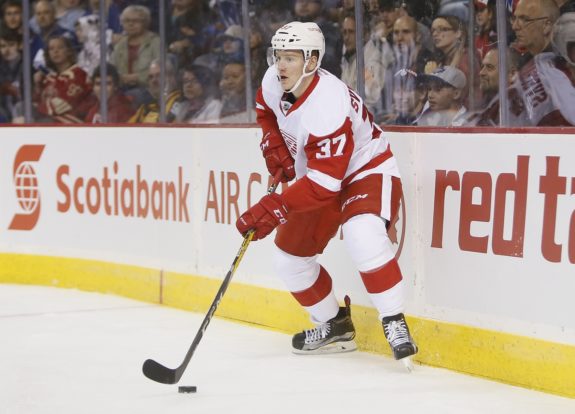
In limited action, Red Wings fans and management got a good look at the NHL player Evgeny Svechnikov can be: His 2.51 even-strength goals for per 60 only trailed Larkin, Mantha, and Bertuzzi among Red Wings forwards. Svechnikov is learning to use his six-foot-two frame down low and still needs work in the defensive end, but have patience – he’s going to be a solid forward for Detroit.
Related: Red Wings & Svechnikov: Patience is Required
Dominic Turgeon: Inc.
Stats: 5 GP – 0 G – 0 A – 0 PTS – 2 PIM
OER: 0.00
DER: 0.75
Though he only played five games and was on the ice for two five-on-five goals against, Dominic Turgeon looked like he’s ready to be a full-time NHLer. The son of former 515-goal scorer, Pierre Turgeon, the young center has impressed at the AHL level, especially on the penalty kill. Expect Turgeon to push hard for a spot on the Red Wings this fall, if he’s healthy.
Luke Witkowski: B-
Stats: 31 GP – 1 G – 3 A – 4 PTS – 68 PIM
OER: 0.94
DER: 1.27
Offense, defense, it doesn’t matter for Luke Witkowski. He was on the ice for about as many five-on-five goals for as you’d expect and allowed fewer goals against than anticipated. He had a few too many minor penalties but was otherwise adequate for his role. It remains to be seen if he’ll have a spot on next year’s team, despite having another year on his contract.
Henrik Zetterberg: A-
Stats: 82 GP – 11 G – 45 A – 56 PTS – 14 PIM
OER: 1.04
DER: 1.12
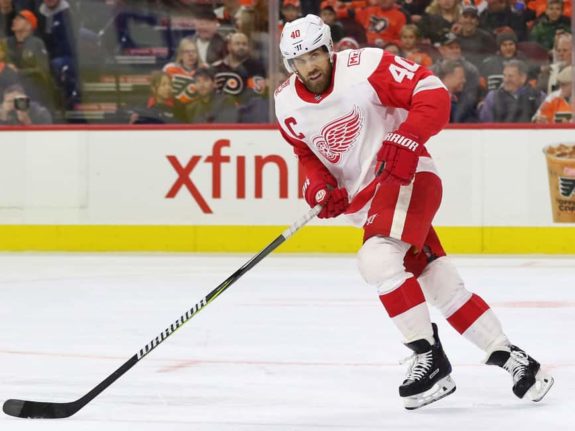
At 37 years old, what more can you expect from Henrik Zetterberg? Despite a balky back, top-line minutes, and overall team adversity, Zetterberg continued to be a consummate pro for Detroit.
Though his foot speed is not that of his younger days, his escapability, strength along the boards, and vision are still top-notch. He put up respectable offensive numbers and was more than capable of defending in his own end. Larkin may be assuming the mantle as Detroit’s go-to center but Zetterberg continues to show why he’s a sure-fire Hall-of-Famer.